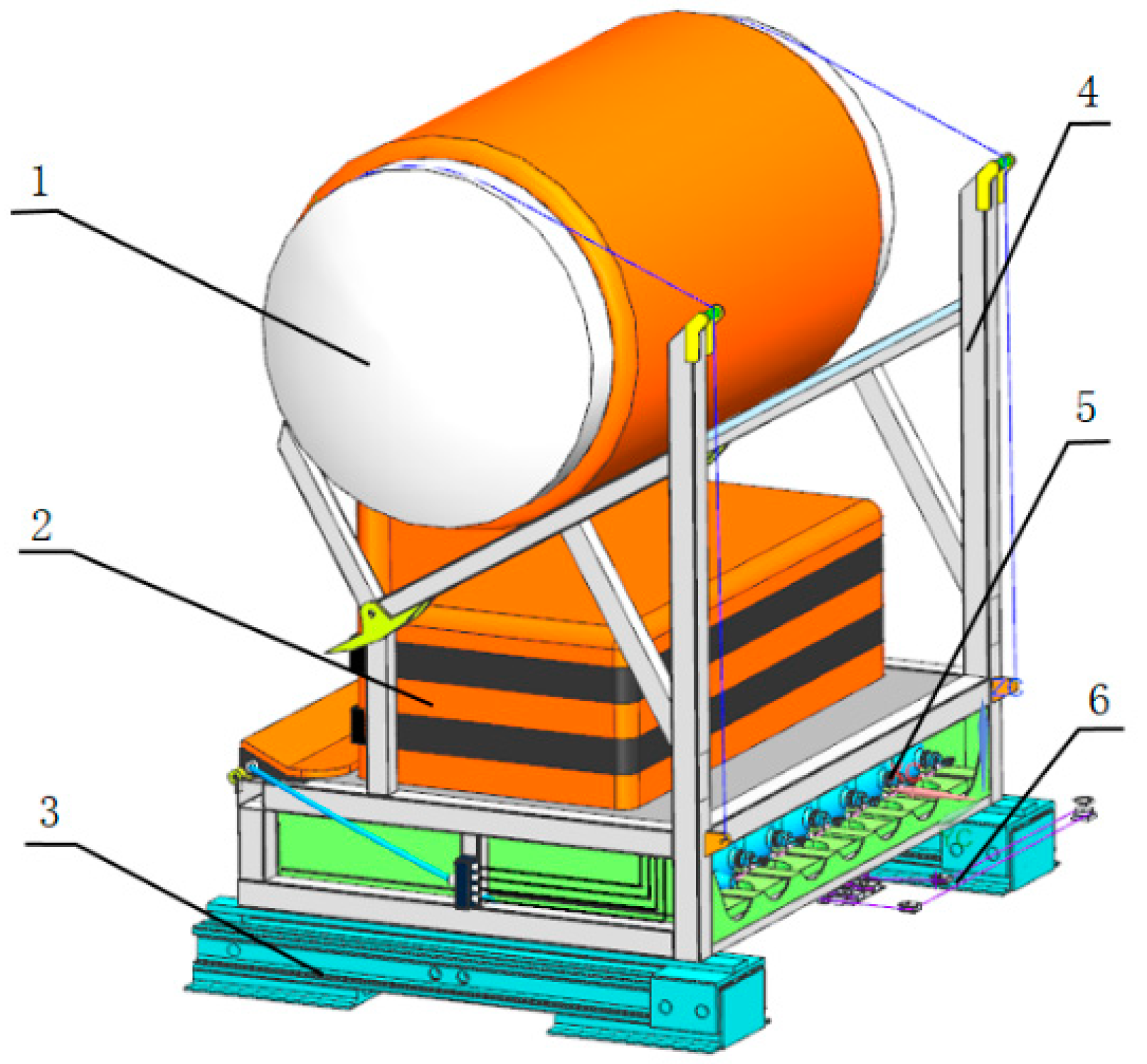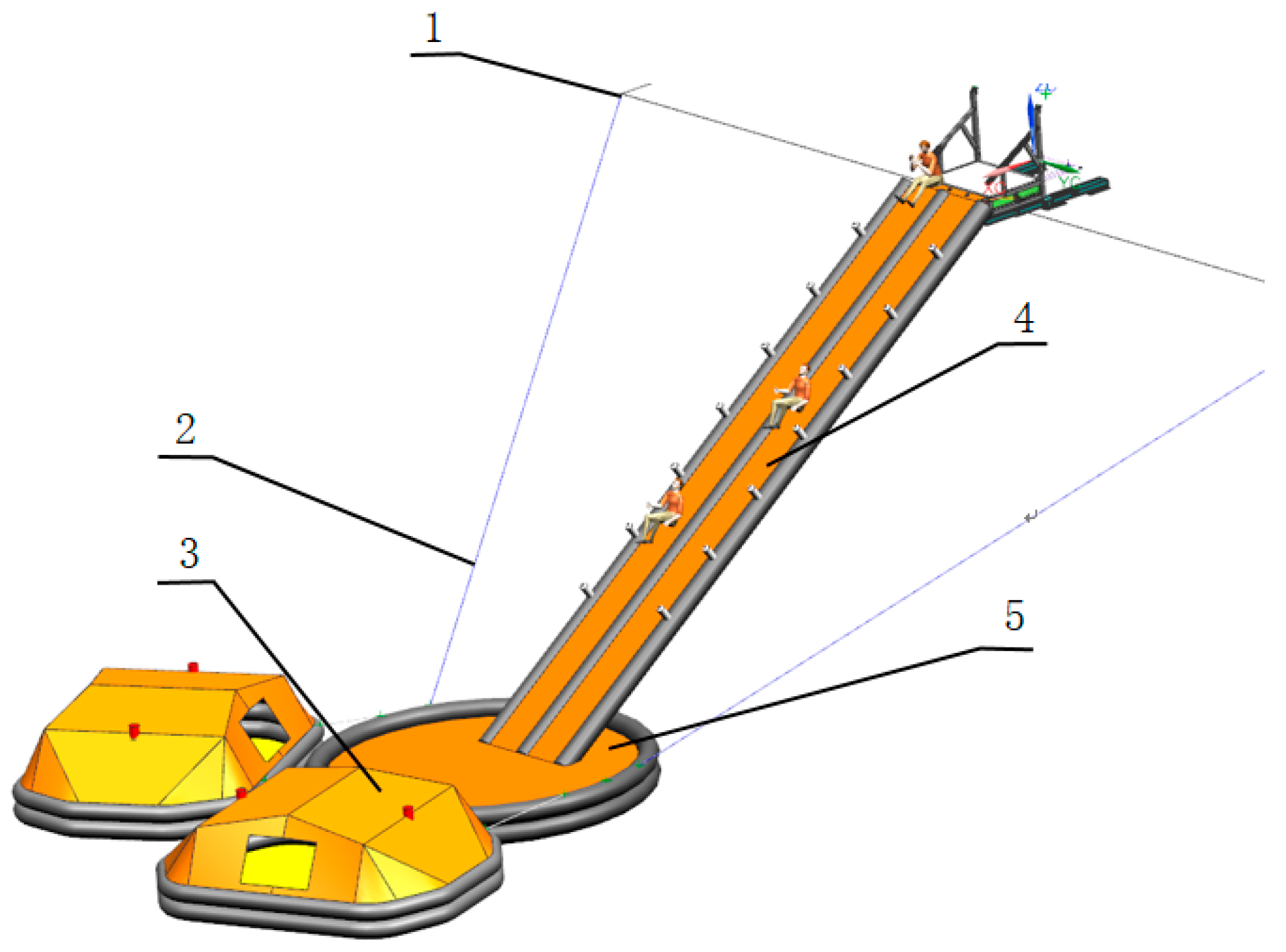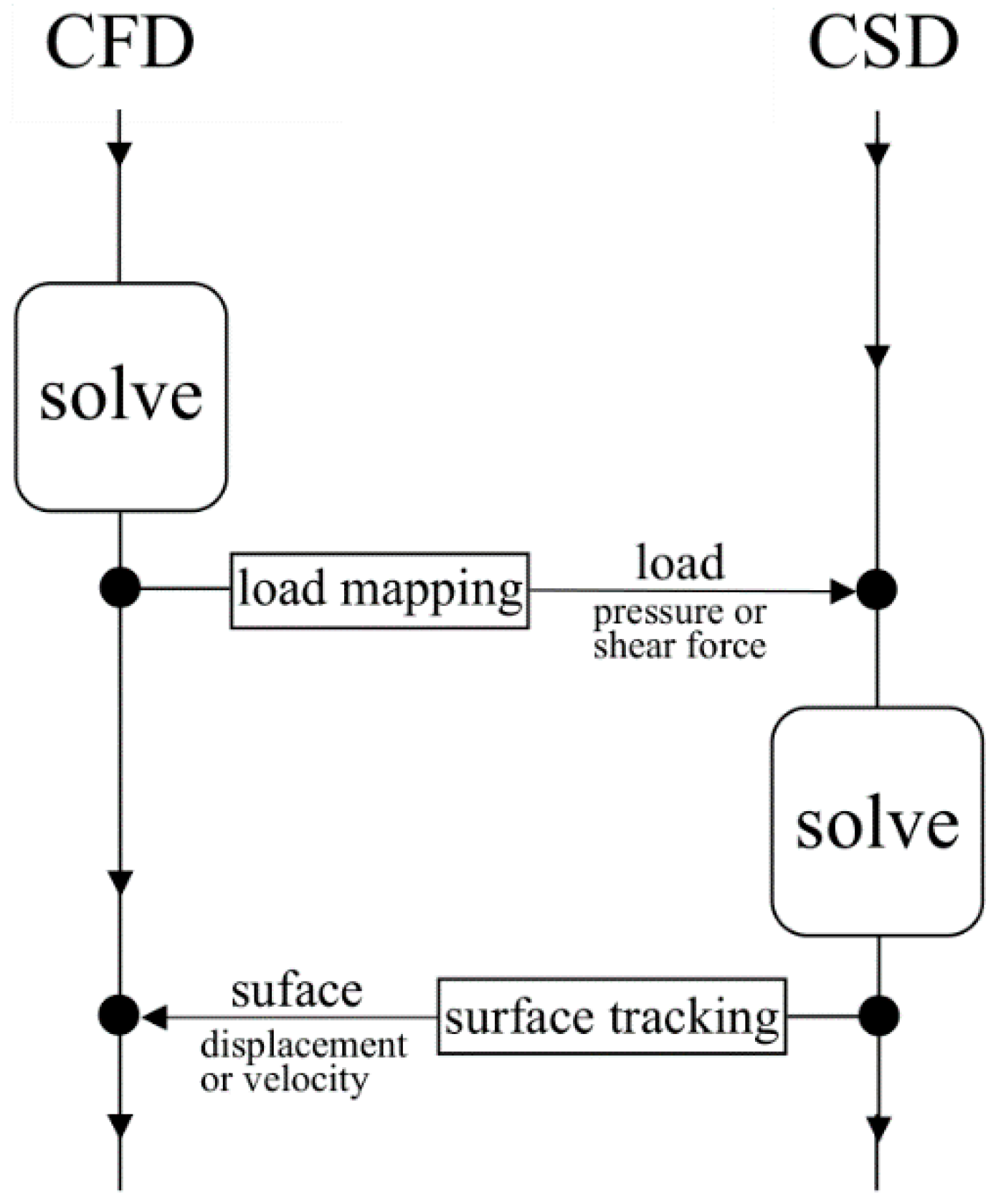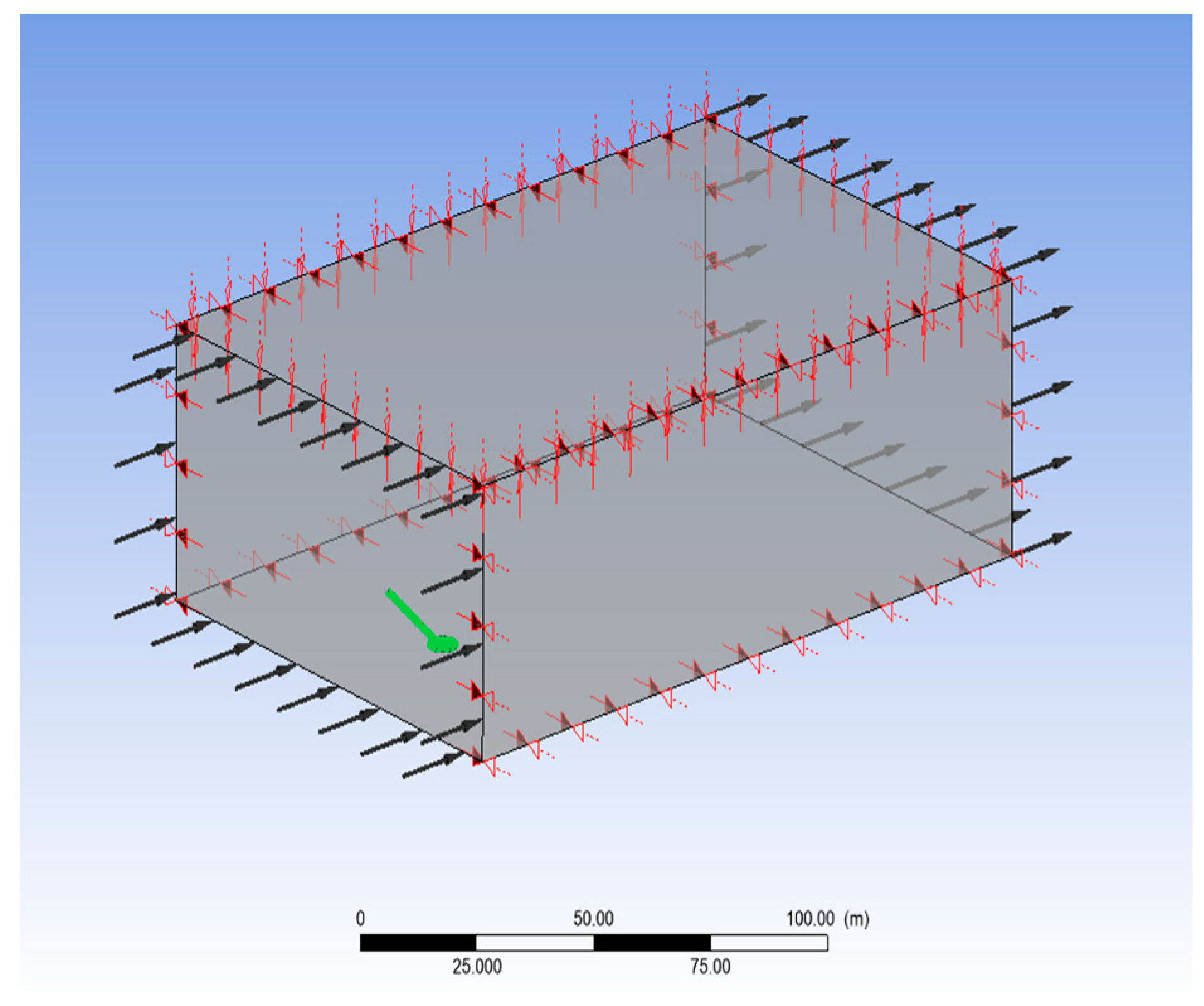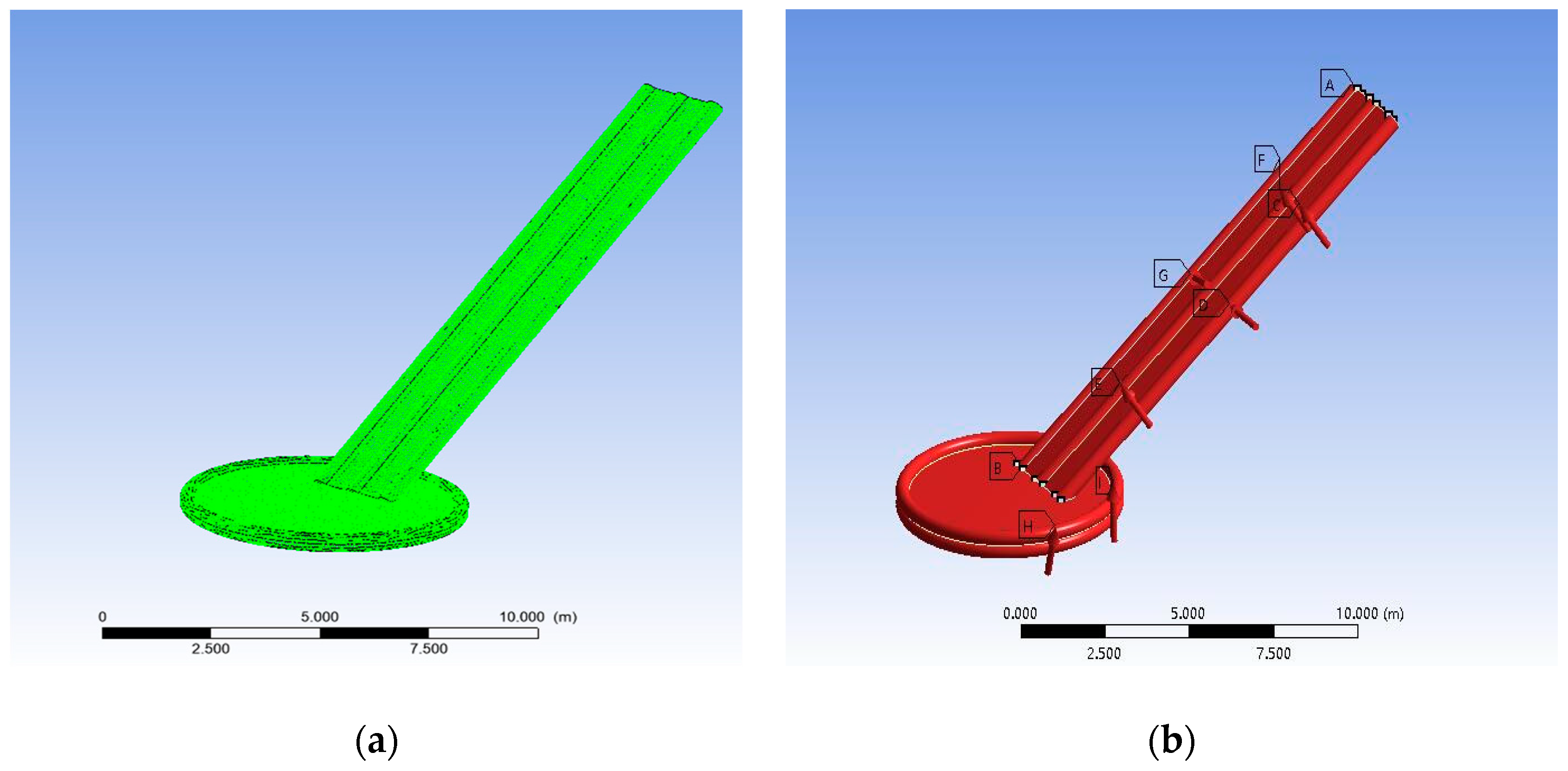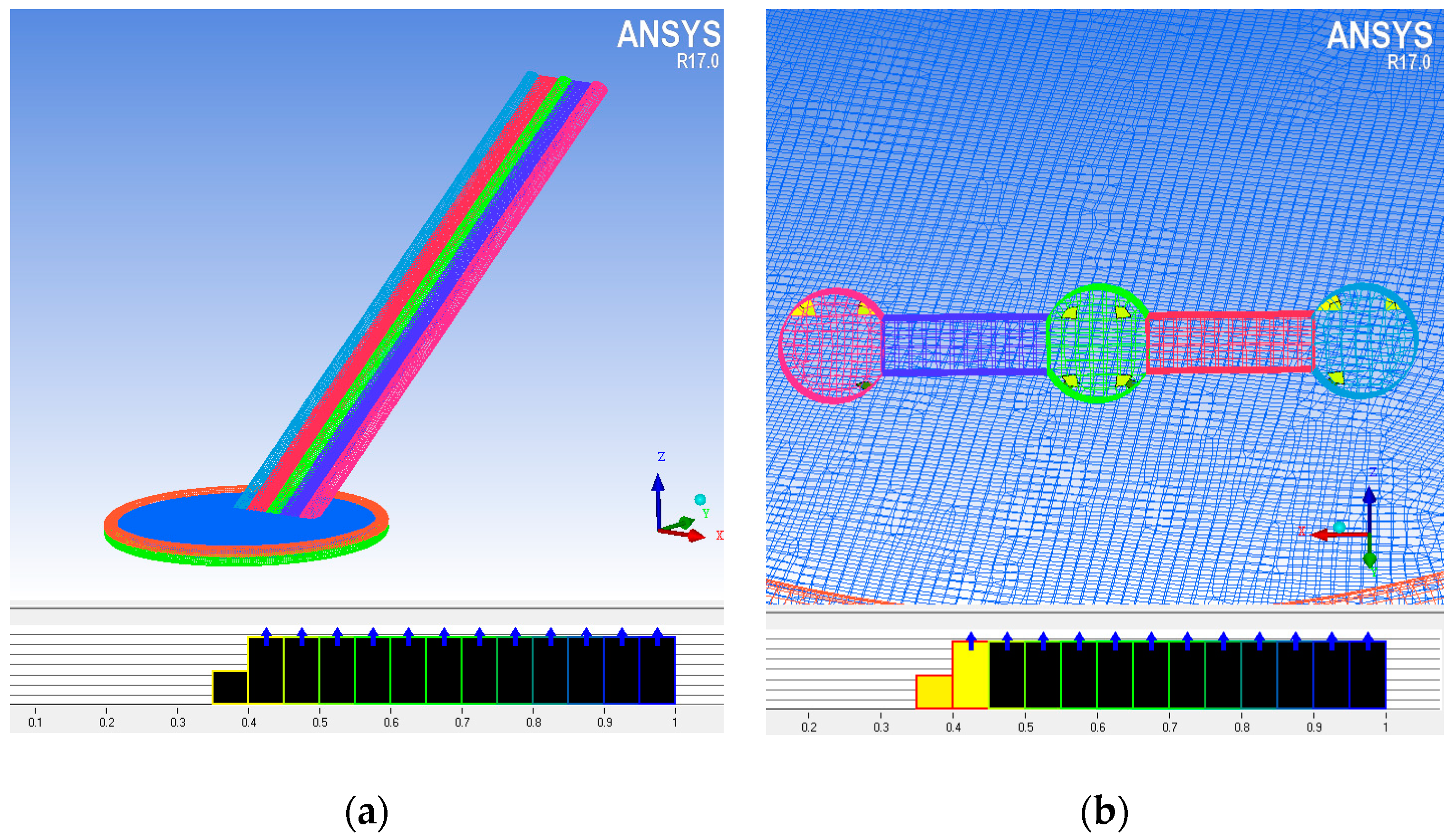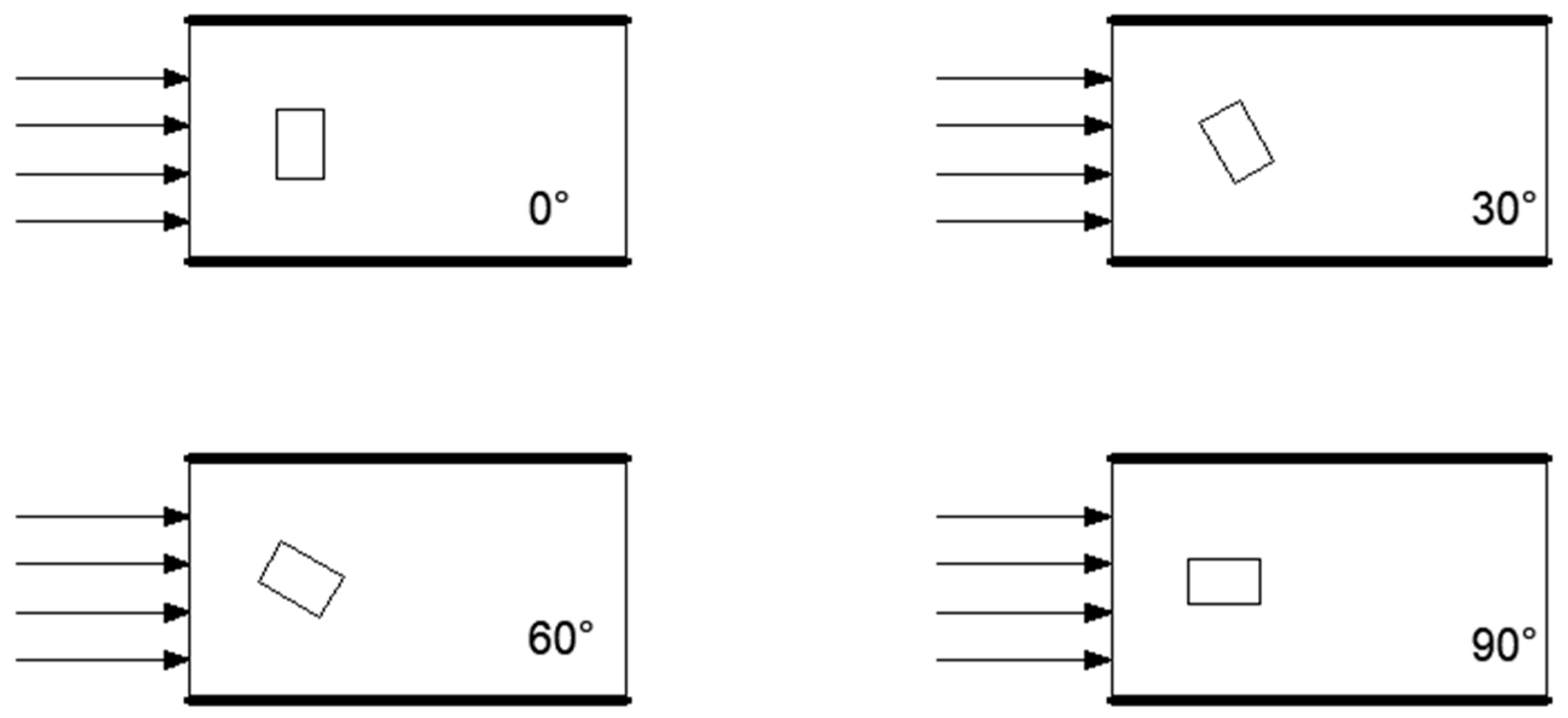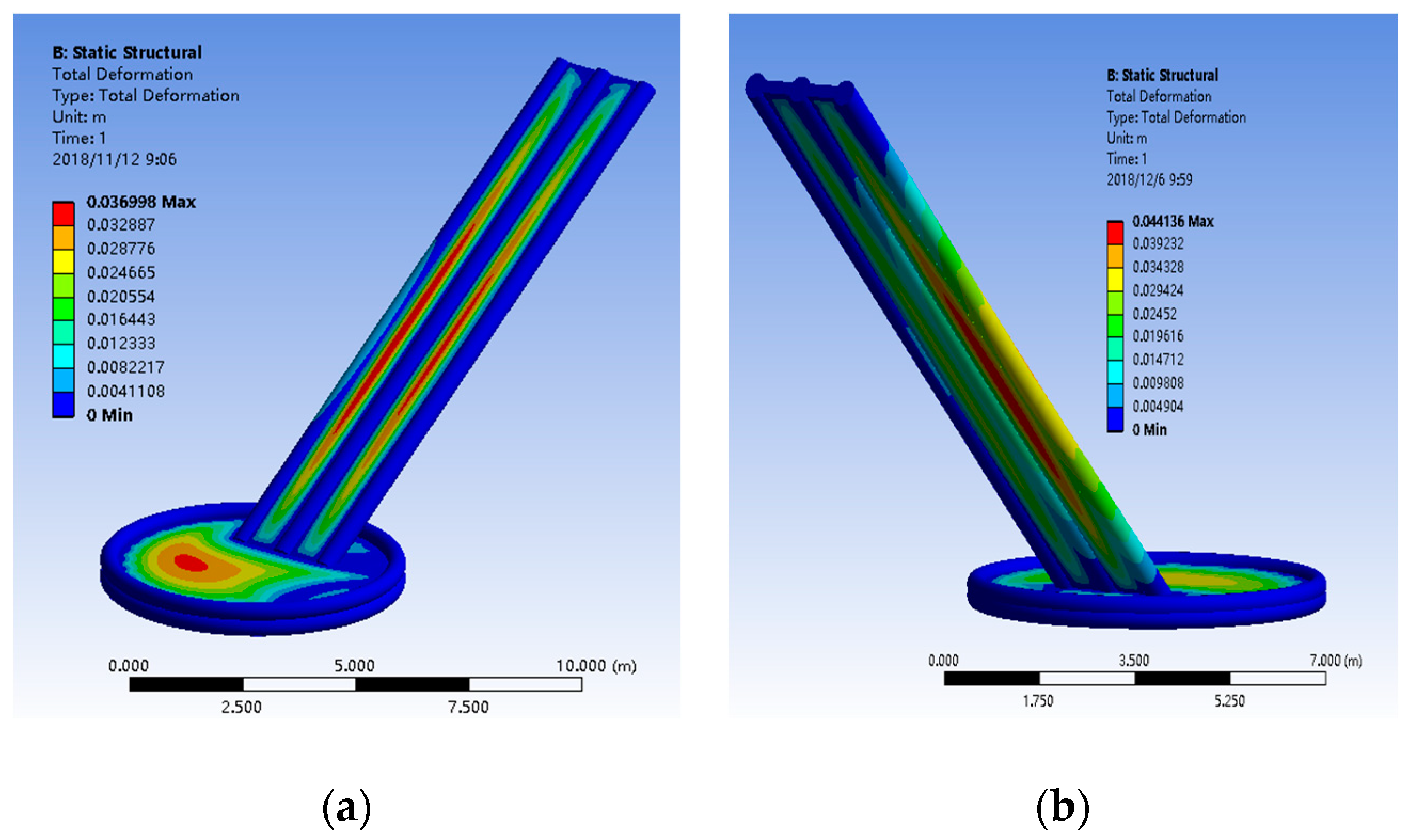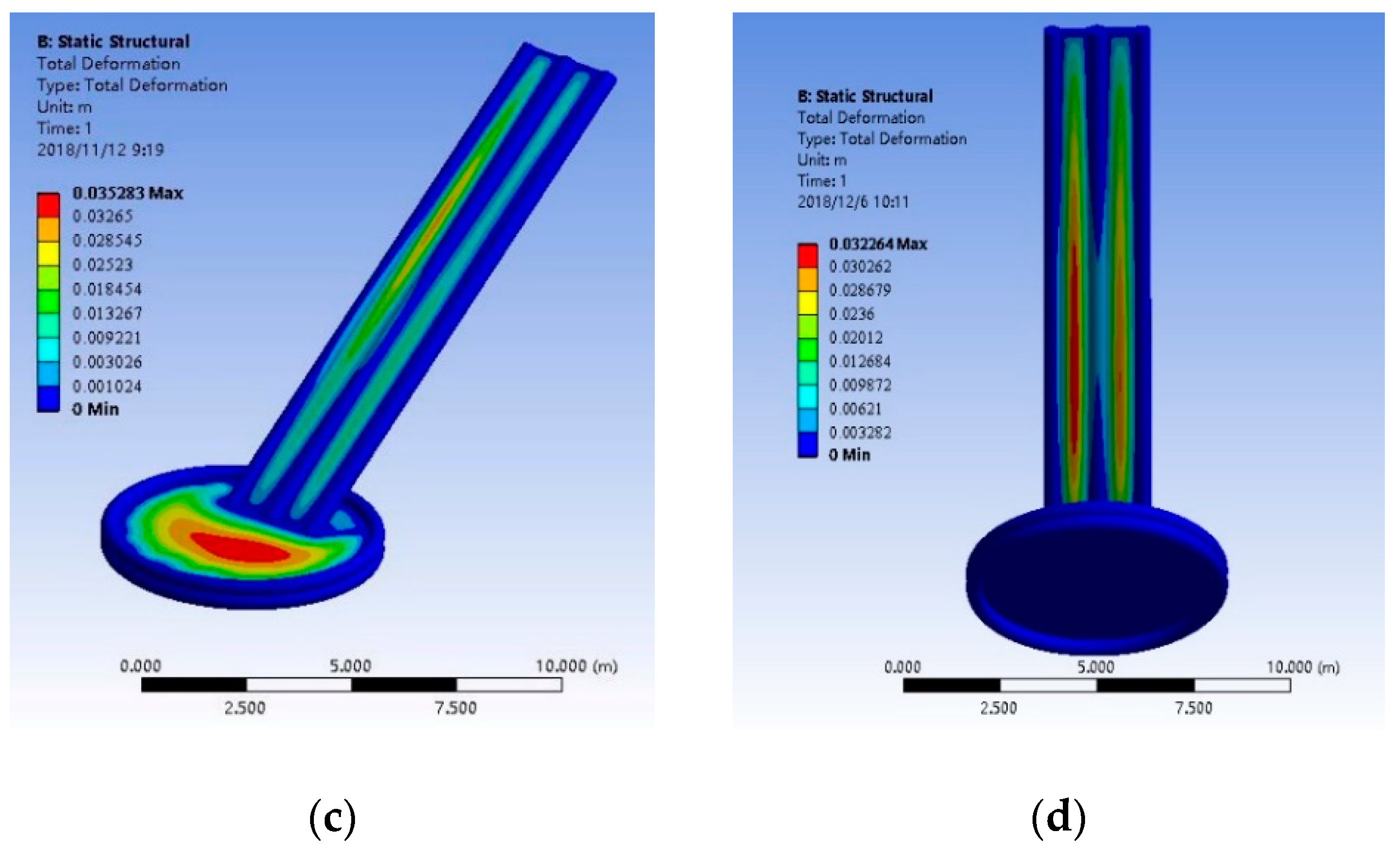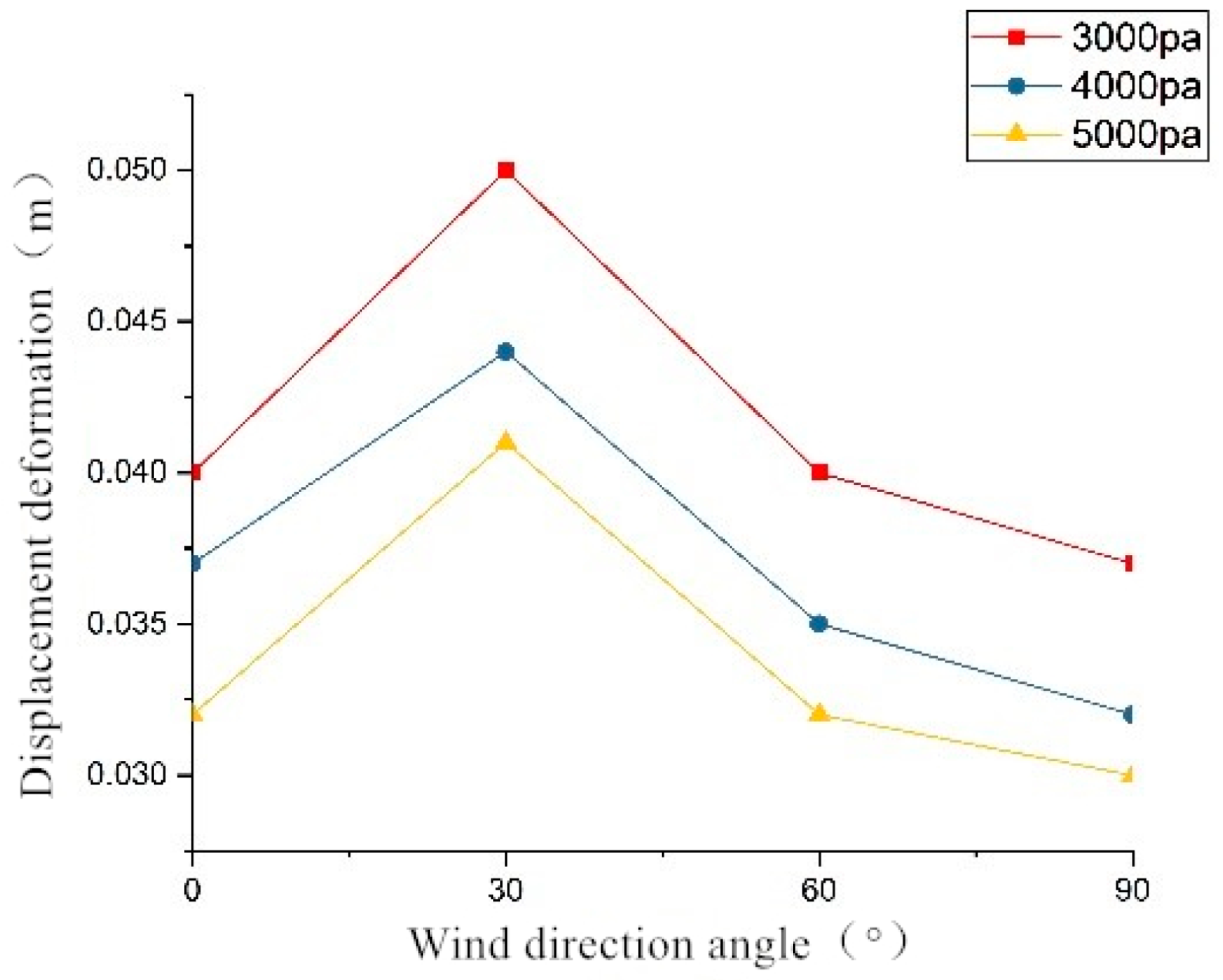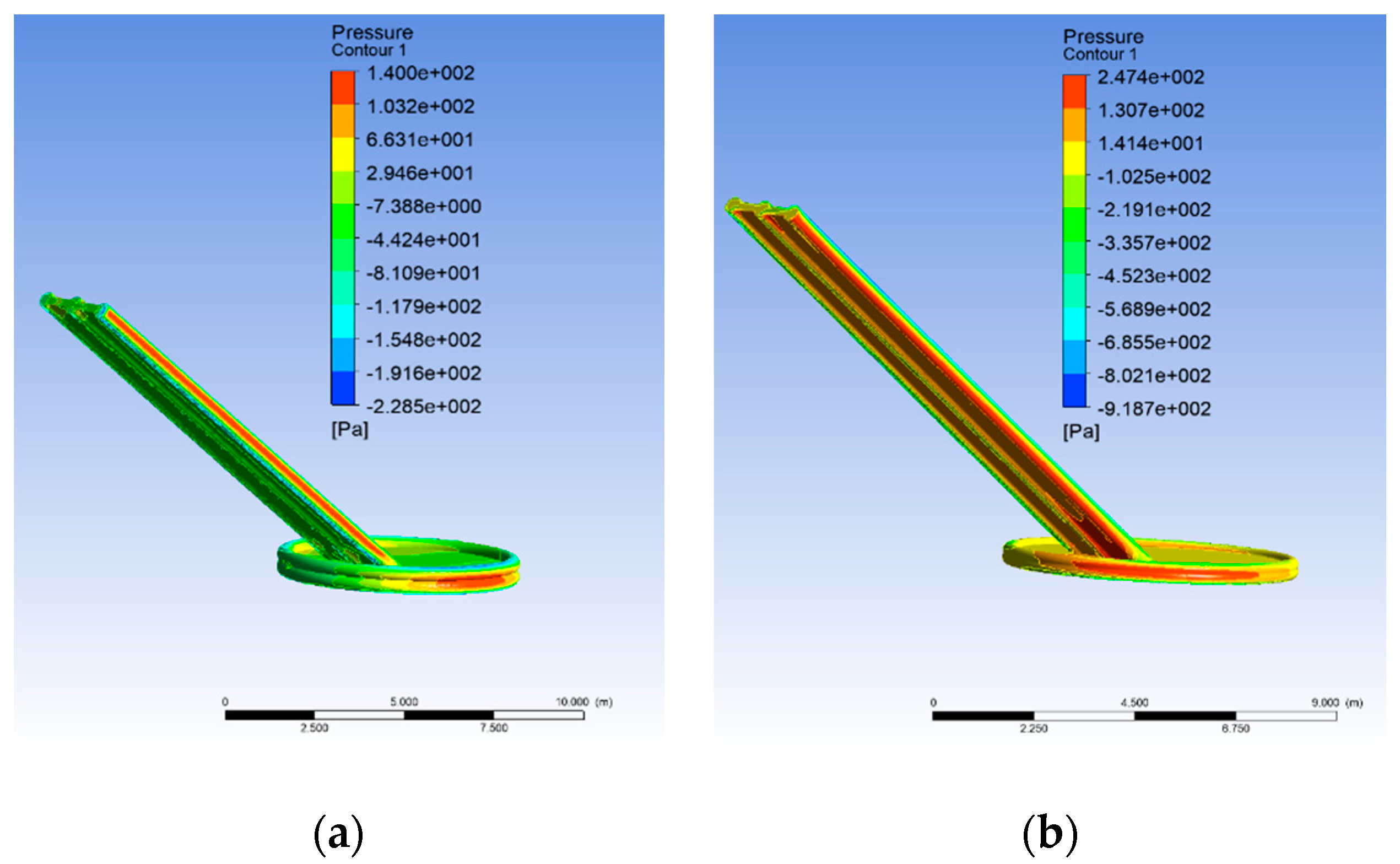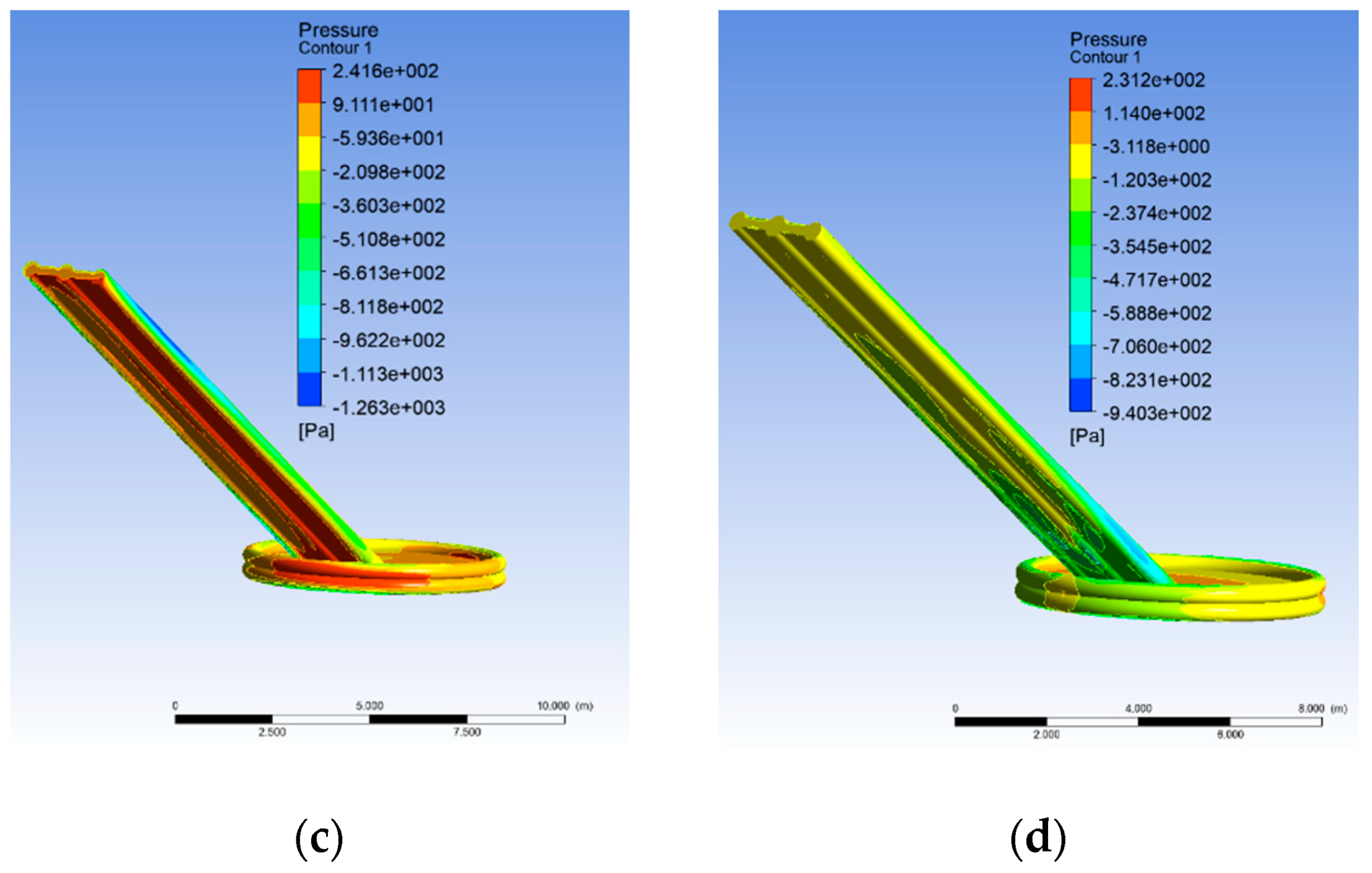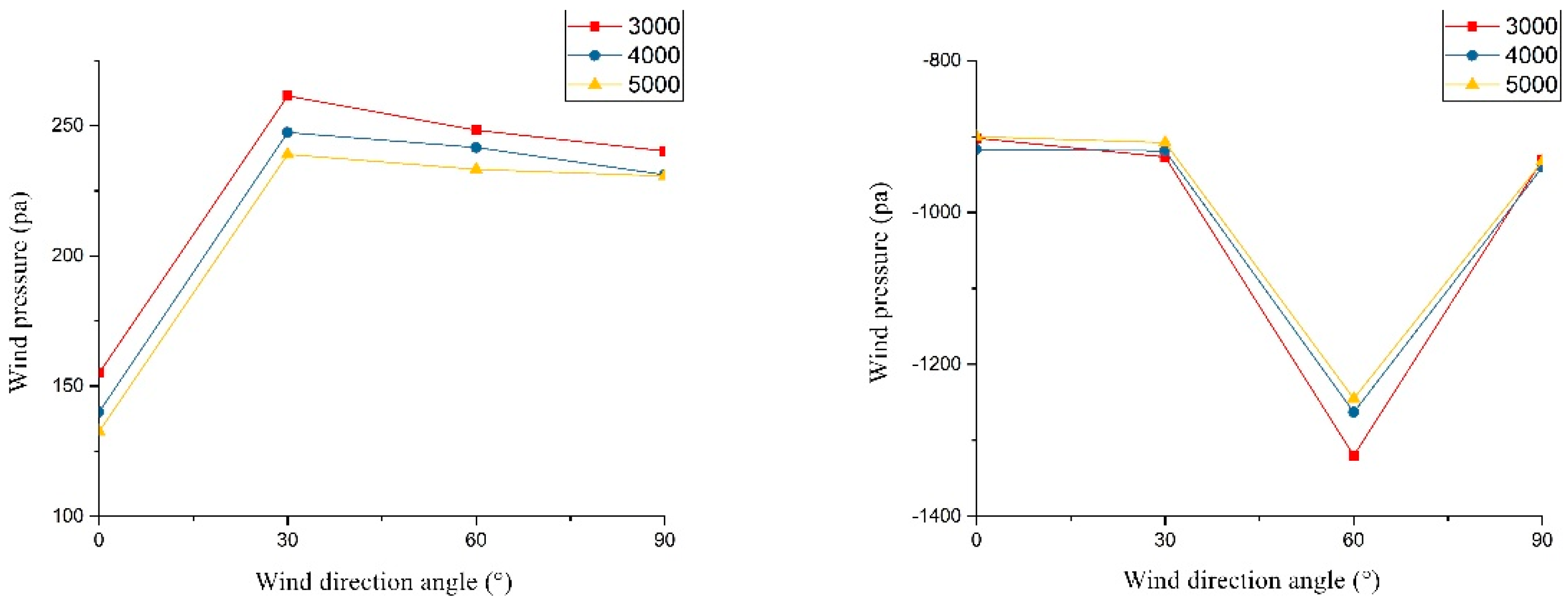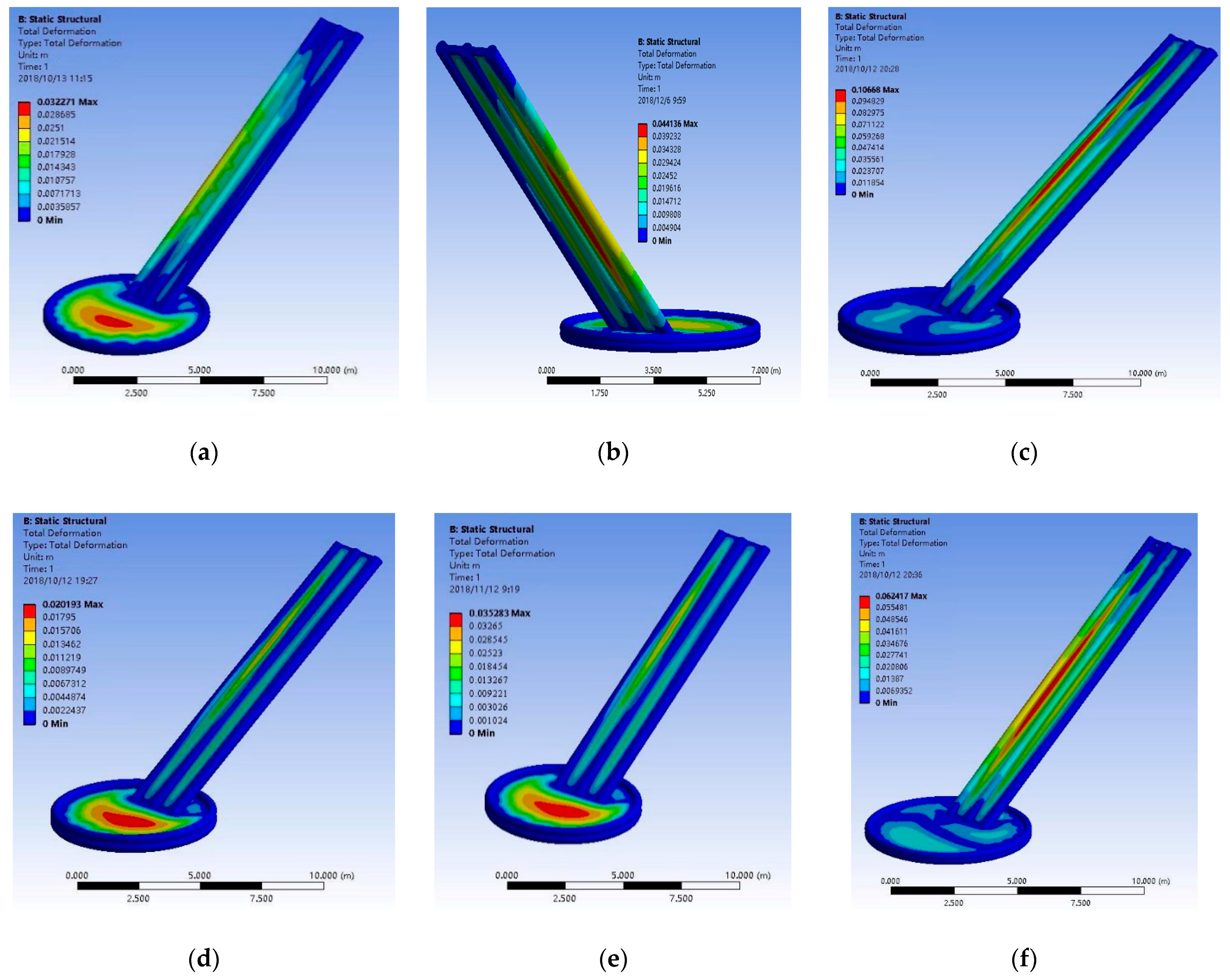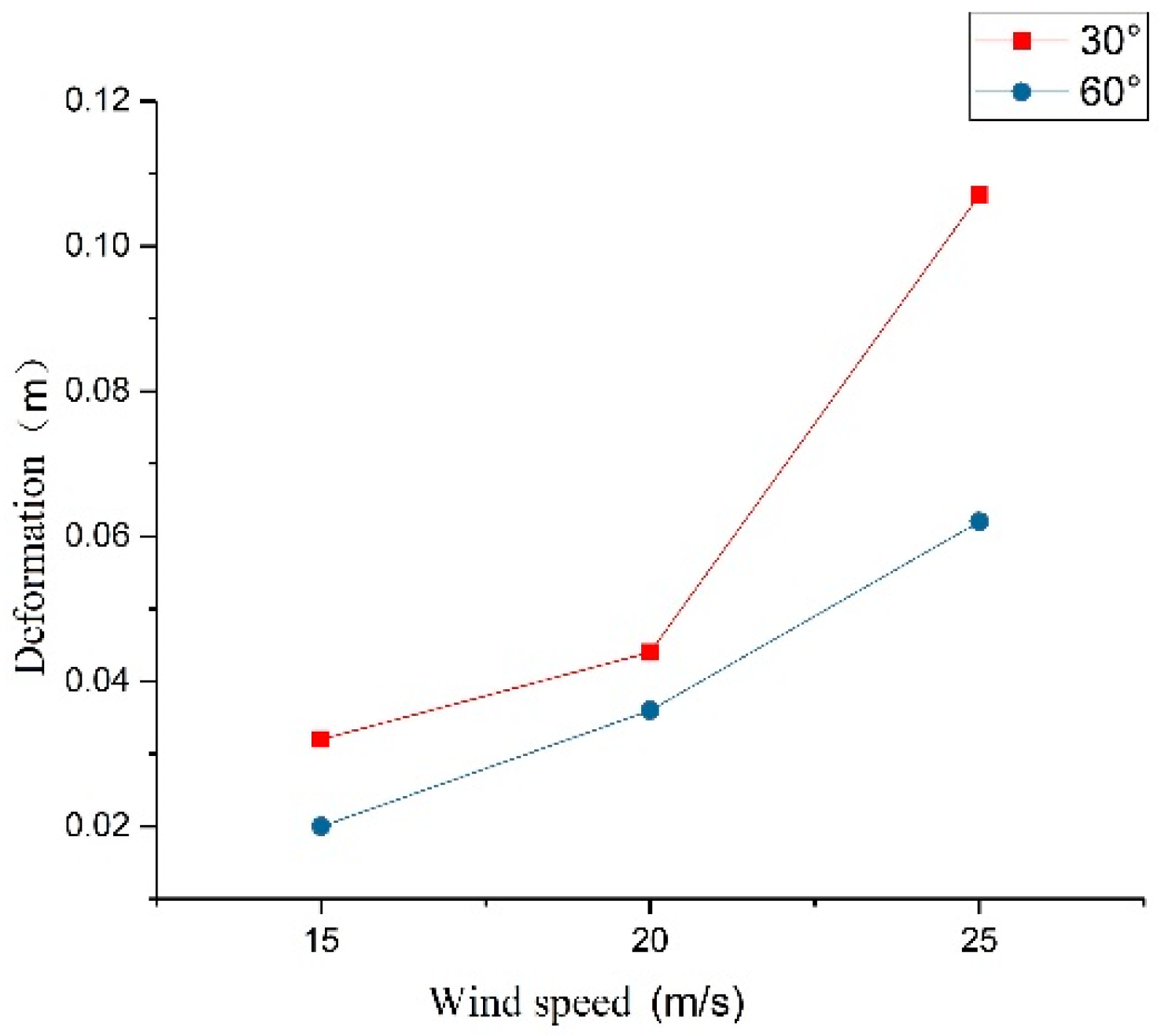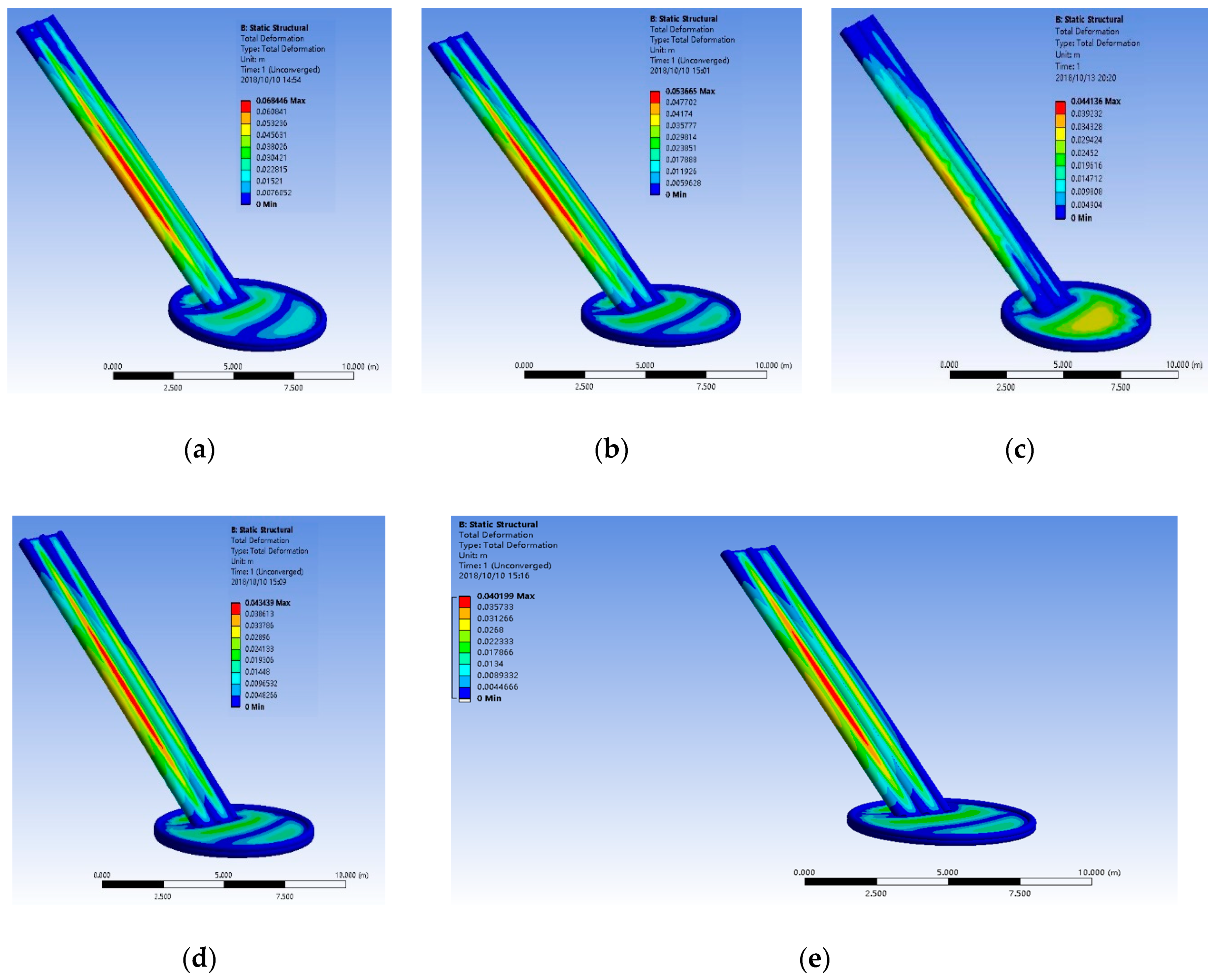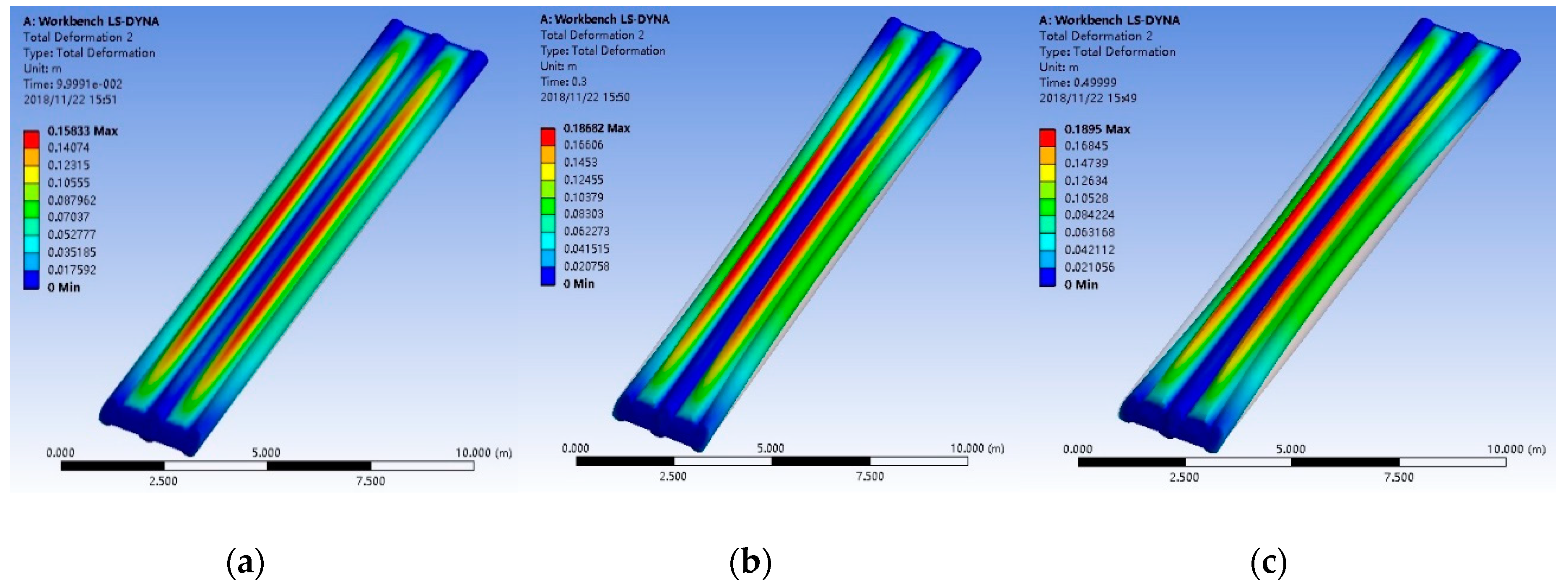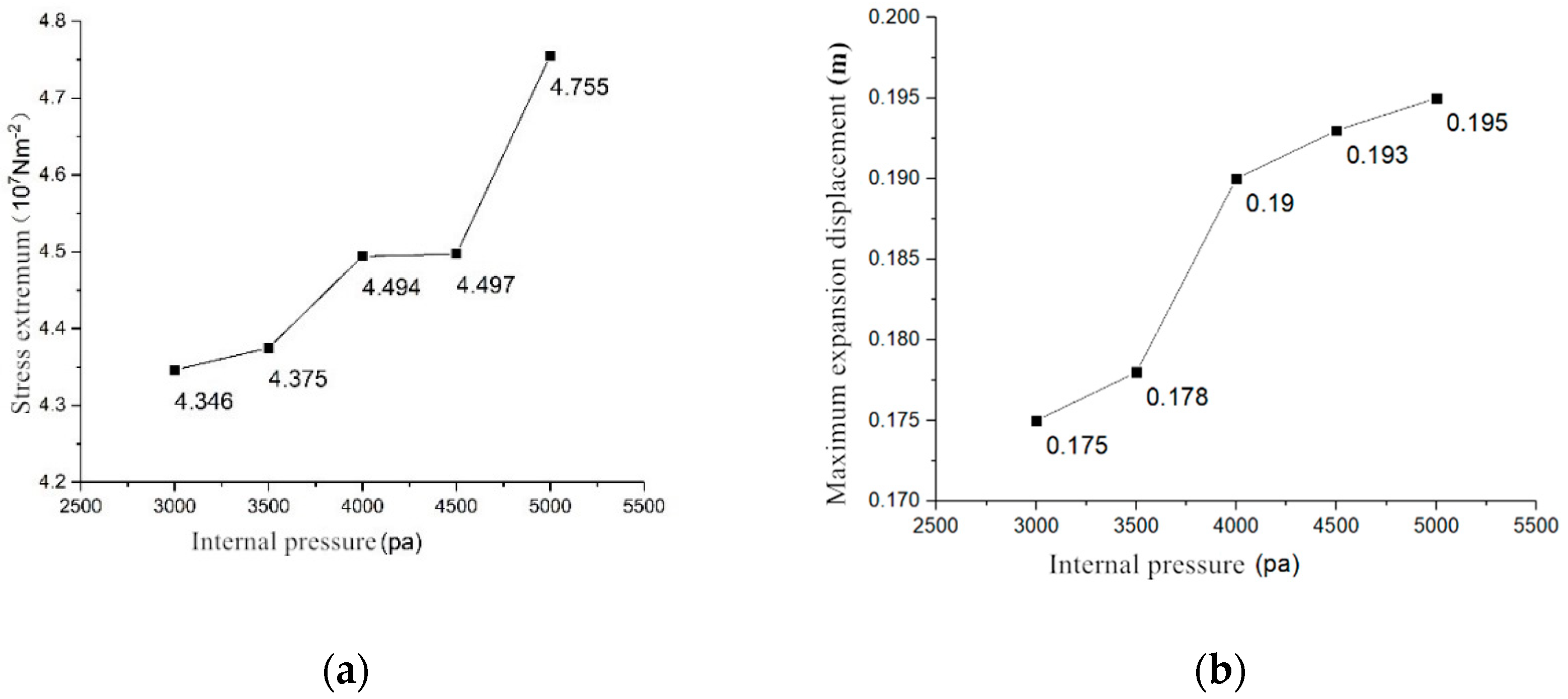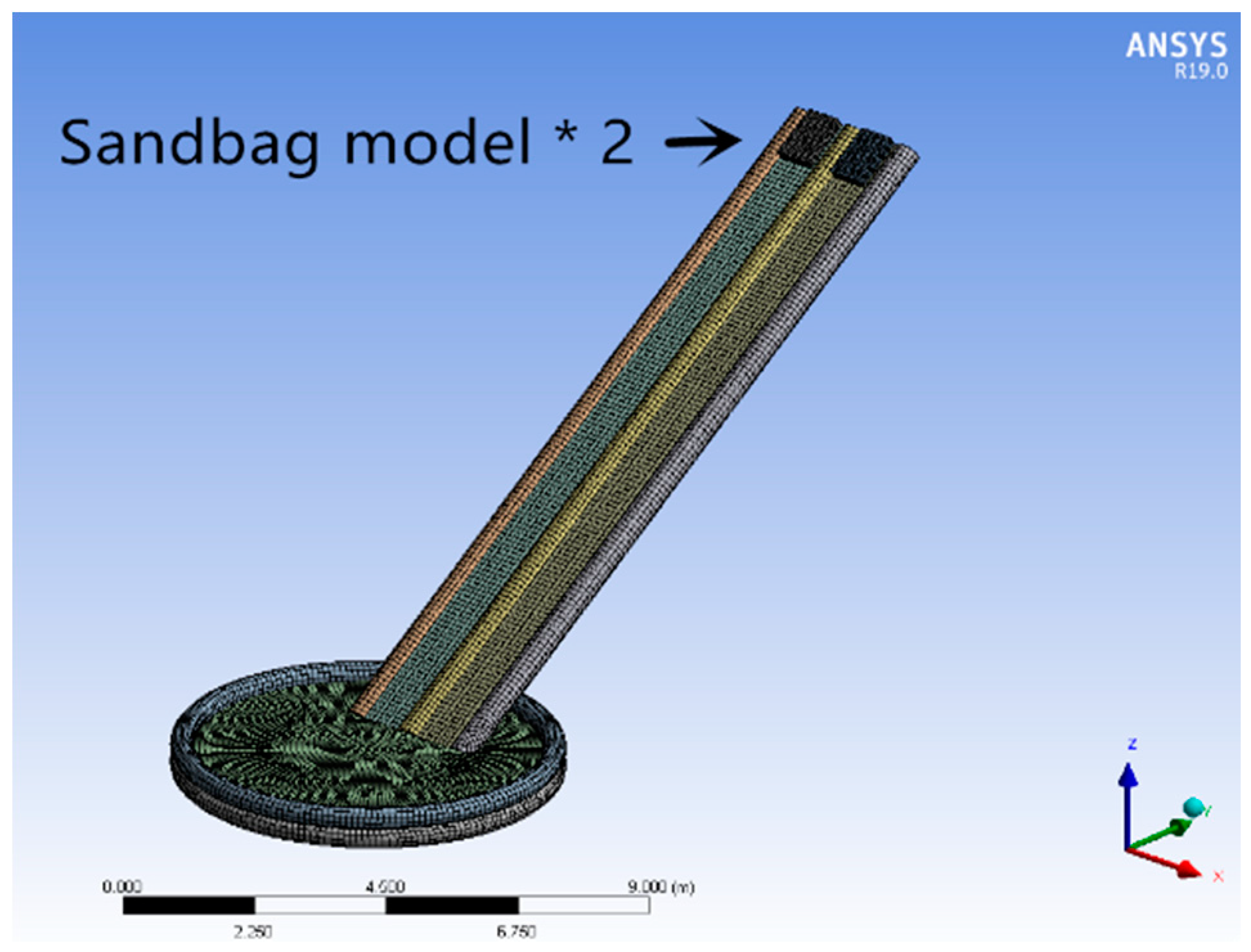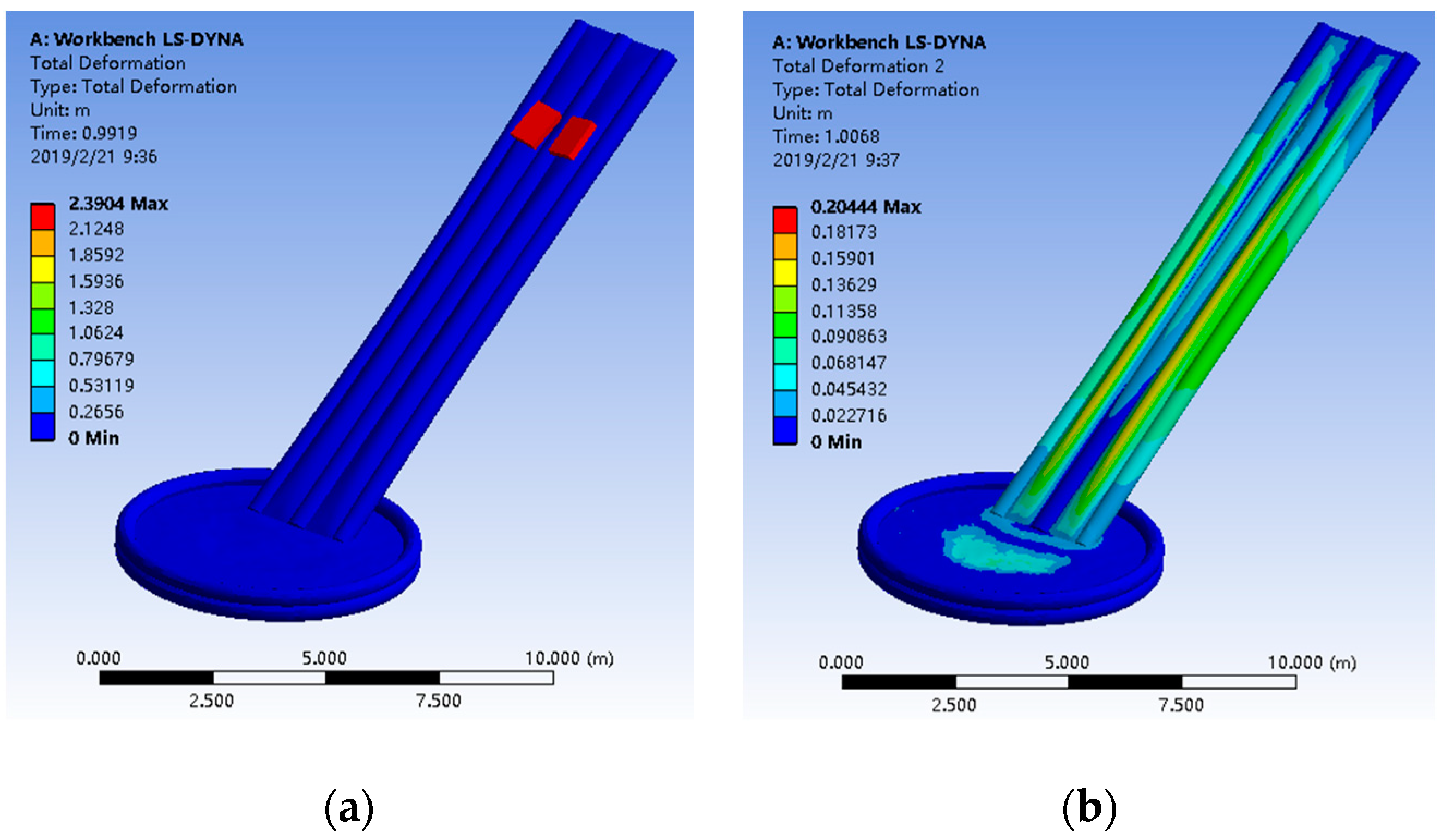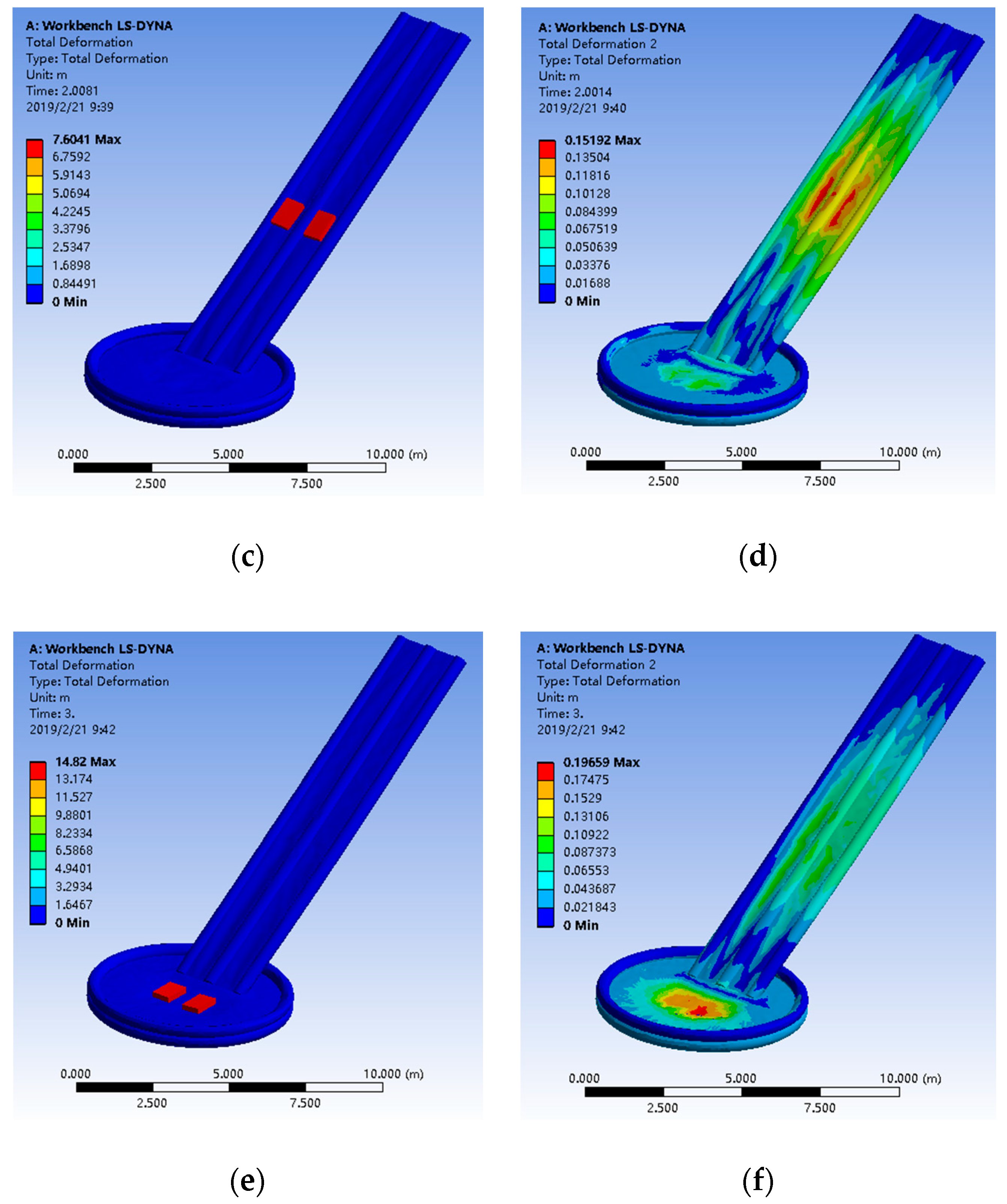1. Introduction
With the increasing dependence of economic development on marine trade, shipping routes are complex and the incidence of various maritime accidents is gradually increasing [
1]. The ocean evacuation system is a kind of lifesaving equipment which can effectively and safely complete the evacuation of ship distress personnel [
2]. The importance and urgency of its research and development are being paid attention by researchers in related fields. The inflatable slide evacuation system is a kind of lifesaving equipment mainly used in the evacuation of distressed persons on roll-on ships. Generally, it is composed of an evacuation box frame, integrated inflatable slide and sea mounting platform, telescopic guide rail, load-carrying frame and air charging device [
3]. The whole system, as shown in
Figure 1, is stored in the evacuation frame and fixed on the decks on both sides of the shipboard in the receiving state.
When the evacuation system is in operation, the slide and the sea lifesaving devices are inflated and deployed, and the connecting cables are fixed on the side of the ship to ensure the stability of the sea lifesaving devices. As shown in
Figure 2, the external geometry of the inflatable slide is irregular, and its surface is made of rubber film, which bears a large area of wind load. At present, there is no validation standard for the response state of a lifesaving inflatable slide under wind load. In practical engineering, the displacement, deformation and wind pressure distribution of flexible film under wind load generally need to be obtained by aeroelastic model wind tunnel test. This method has a long test period, a large investment, and often uses the scaled rigid model in the test, ignoring the effect of fluid–solid coupling effect, and cannot completely and accurately reflect the actual situation.
Experts and scholars in related fields have made pioneering explorations on the application of finite element numerical simulation methods in response analysis of flexible membrane structures. With the deepening of research and the development of scientific research means, the physical model test method is gradually replaced by the computer numerical simulation analysis method [
4].
Xiang carried out wind tunnel tests on the umbrella rigid roof structure, changing wind speed, wind direction and other conditions, and obtained the corresponding fluid pressure distribution of different input parameters on specific structure, and further obtained the law of fluid pressure distribution [
5]. Glück carried out data transmission between CFD (computational fluid dynamics) and CSD (computational structural dynamics) through an intermediate data exchange platform. The indirect calculation method was used to simulate the fluid–structure coupling between wind and membrane structures [
6]. A time-varying fluid–structure coupling method for thin shell large displacement membrane structures was also proposed [
7]. Zhu used the numerical simulation method of interaction between the enclosed saddle-shaped membrane and wind to study structural vibration and the interaction′s effects on the membrane′s wind response [
8]. Wood studied fluid–structure interaction of hemispherical membrane structures of three Reynolds numbers (50,000, 75,000, 100,000) by using wind tunnels, and obtained deformation responses of hemispherical membrane structures under different flow conditions [
9]. Ran investigated the wind load and wind environment of three typical air-supported membrane structures with different rise–span ratios in different wind directions by using the LK k-ε model [
10].
The above research has made great progress in the analysis of the wind-load response of inflatable membrane structures, but in the process of research, the simple verifiable model was often used instead of the actual engineering model, and no detailed quantitative analysis of the response law was carried out, so the research results cannot directly provide data support for the actual engineering problems. In a wind tunnel test, the rigid model was often used to replace the real model in the early test of the wind-load response of thin films. The results will inevitably have some errors. This defect also reflects the necessity of using CFD virtual simulation to solve such problems.
In this paper, based on an inflatable evacuation system for a passenger-rolling ship, numerical models of wind field and inflatable membrane sliding structure are established, and a mathematical model of information transfer and exchange between multi-field interaction interfaces is established by using simplified theory. The dynamic response law of inflatable sliding under multi-variable wind field load is obtained by using CFX fluid–solid coupling algorithm. The most dangerous condition of the evacuation system and the ideal inflatable internal pressure satisfying the stability requirement are reached. The LS-DYNA module is used to complete the inflation simulation of the inflatable slide and the simulation of the personnel sliding process. The influence law of the change of air pressure on the structural rigidity and the personnel evacuation efficiency is obtained, and the ideal inflatable internal pressure meeting the evacuation efficiency standard is obtained. The purpose is to provide some technical data support for the offshore application of inflatable membrane structures.
3. Wind-Load Response Analysis of Inflatable Slide under Fluid-Solid Coupling
In order to analyze and simulate the response of the emergency inflatable slide in the wind field during the actual work of the sea surface, it is necessary to take full account of the wind field variables, and through the introduction of different parameters, the results of the overall wind pressure distribution and displacement response of the inflatable slide are obtained. The wind direction angles considered here are 0°, 30°, 60° and 90°, and the sea surface wind speeds are 15 m/s, 20 m/s, and 25 m/s. According to the pressure regulation of the inflatable life raft in the international lifesaving equipment and rules, the pressure of the inflatable life raft in combination with the fishery lifesaving equipment is 30 mm mercury column (4000 Pa). The simulated atmospheric pressures are 3000 Pa, 3500 Pa, 4000 Pa, 4500 Pa, and 5000 Pa as the atmospheric pressure varies. When adjusting the variables, the sea surface wind field is guaranteed to remain unchanged.
3.1. Wind-Load Response of Emergency Inflatable Slide under Different Wind Direction Angles
Different wind directions have great influence on the motion response of offshore structures. When a ship is in distress at sea, the most unfavorable wind direction can be obtained during the analysis of the deformation and wind pressure distribution data of its evacuation system caused by different incoming winds [
16]. According to the size characteristics of the evacuation system involved in this paper, the geometrical size of the flow field area is set to 150 m × 100 m × 50 m. We set air pressure variable (4000 Pa) and wind speed variable (20 m/s), and carried out numerical simulation analysis. The layout of inflatable slide at different wind directions on the sea surface is shown in
Figure 7.
Due to the fluid–solid coupling response, the inflatable slide is deformed by wind loads, which in turn will give feedback to the wind pressure distribution on the surface of the inflatable slide [
17]. The numerical simulation of the airflow field of the inflatable slide is carried out under different wind direction angles and the simulation results are obtained. The displacement and deformation of the inflatable slide under different wind directions are shown in
Figure 8.
When the wind direction is 0°, the maximum displacement deformation occurs on the surface of the inflatable slide and on the platform area, which is about 0.037 m. When the wind direction is 30°, the maximum displacement occurs at the back of the slide, which is about 0.044 m. This deformation is also the maximum of the displacement deformation of the slide at each wind direction angle. When the wind direction is 60°, the maximum displacement occurs on the surface of the landing platform of the inflatable slide, which is about 0.035 m. When the wind direction is 90°, the maximum displacement deformation occurs at the back of the slide surface, which is about 0.032 m. The displacement extremes under different condition variables are summarized in
Table 1.
From the above simulation data, as shown in
Figure 9, it can be seen that the different wind direction angles have great influence on the displacement deformation of the flexible inflatable membrane. Among the effects of each wind direction angle, the wind direction angle of 30° has the most obvious effect on the inflatable slide, and the displacement deformation is the largest.
Wind pressure distribution in the wind field is an important factor to measure the stability of the emergency inflatable slide when it is laid out on the sea surface [
18]. In the simulation process, if the wind pressure value is positive, then the wind pressure direction is vertical sliding surface inward, while the wind pressure value is negative, then the wind pressure direction is vertical sliding surface outward. In CFX fluid analysis, the distribution of wind pressure will be distinguished according to the numerical value [
19]. The boundary of the same color area is called the isoline. The sparse and uniform distribution of the isoline represents the stable change of partial pressure, while the dense distribution of the isoline means the drastic change of wind pressure.
As shown in
Figure 10,
Figure 11 and
Table 2, according to the response analysis of the inflatable evacuation slide under different wind directions, it can be concluded that the maximum displacement deformation and the maximum positive pressure distribution are found in the slide with wind direction angle of 30°, and the maximum negative pressure distribution is found in the slide with wind direction angle of 60°. The distribution of wind pressure under the above two wind directions is asymmetrical and the wind pressure isoline is dense, which proves that the stability of the inflatable slide is poor in this case.
3.2. Wind-Load Response of Emergency Inflatable Slide under Different Wind Speed
In the design and analysis of sea lifesaving inflatable equipment, the wind speed gradient should be detected, and the simulation wind speed level should be improved appropriately, so as to achieve a sufficient safety factor. The ability to withstand wind speed variations is also a necessary test element for sea surface evacuation equipment [
20]. In this section, the displacement and deformation response of the inflatable slide under the wind load of 15 m/s, 20 m/s, 25 m/s, and 30° and 60° wind directions are simulated. The numerical simulation results are shown in
Figure 12.
The ability of resisting wind speed variations is tested to find out the most dangerous condition of inflatable slide arrangement, which can be used for the wind-load response analysis of the inflatable slide when air pressure changes.
As shown in
Figure 13, according to the results of displacement and deformation of the inflatable slide under different wind speeds, it can be seen that with the increase of wind speed, the displacement and deformation of the inflatable slide under different wind directions increases gradually. The displacement values at a wind direction angle of 30° are higher than those at a wind direction angle of 60° at all wind speed monitoring points. The slope of displacement and deformation growth at a direction angle of 30° is higher than that at a direction angle of 60°. The above shows that the displacement deformation of the inflatable slide under wind load is the largest under the condition of 30° of wind direction angle, and its ability of resisting wind speed change is poor. To sum up, the wind direction angle of 30° is the most disadvantageous condition for emergency evacuation of inflatable slide.
3.3. Wind-Load Response of Emergency Inflatable Slide under Different Inflation Pressure
From the content of the previous section, it can be seen that the wind direction angle of 30° is the most disadvantageous condition considering the changes of wind direction and speed. This section will not analyze the other working conditions. It will study the response of the internal pressure of the structure to the wind load by changing the inflatable internal pressure for the representative wind direction angle of 30°.
The inflatable internal pressure range is 3000 Pa, 3500 Pa, 4000 Pa, 4500 Pa, and 5000 Pa. As shown in
Figure 14, the simulation results show that with the increase of the internal pressure of the inflatable slide, the displacement deformation decreases, which indicates that the increase of the air pressure obviously improves the anti-wind stiffness of the slide.
It can be seen from
Figure 15 that when the inflatable internal pressure is lower than 4000 Pa, the displacement deformation of the inflatable slide decreases obviously with the increase of the internal pressure. When the inflatable internal pressure is higher than 4000 Pa, the displacement deformation of the inflatable slide no longer changes significantly, and the range of change is within 1 cm, which can meet the requirements of use. Under the action of wind load, there exists ideal internal pressure in the slide of the emergency evacuation system. When the internal pressure is lower than the ideal internal pressure, the displacement deformation changes greatly and does not reach enough rigidity. When the ideal internal pressure range is reached, the displacement deformation changes are no longer obvious. Redundant inflatable internal pressure means that the evacuation system needs to carry more gas cylinders, which will occupy more storage space and prolong the time of inflatability and deployment of the facilities, thus reducing the speed of the evacuation system.
Within the range of inflatable internal pressure studied in this section, 4000 Pa is an ideal inflatable internal pressure.
4. Simulation and Analysis of Inflation and Evacuation Efficiency of Emergency Evacuation Inflatable Slide
According to the International Safety Rules for High-Speed Vessels, the design of evacuation facilities should enable ships to evacuate passengers completely within the evacuation time under controlled circumstances [
21]. The evacuation time (
) is one third of the structural fire protection time (
) of the main fire hazard area minus the 7 min required for the initial detection of danger and removal of the hazard [
22].
In the Equation, is the time of structural fire protection (min). The time of structural fire prevention of high-speed ships studied in this paper is 30 min, and the evacuation time is calculated as 7 min.
4.1. Validation and Simulation of the Inflation Process of Emergency Evacuation Slide
The AIRBAG module in LS-DYNA was used to define the gas in the chamber of the inflatable evacuation slide, so that the gas in the slide can satisfy the ideal gas state equation [
23]. According to the response analysis results of the emergency evacuation slide under different inflatable internal pressures, the evacuation efficiency of the inflatable slide is simulated by the inflatable internal pressure values of 3000 Pa, 3500 Pa, 4000 Pa, 4500 Pa, and 5000 Pa. It is expected that through the simulation of the inflatable internal pressure range, the ideal internal pressure value which meets the criterion of the evacuation system sliding efficiency can be found, and the analysis of the stability part of the inflatable slide can be considered comprehensively. Next, we take 4000 Pa inflatable internal pressure as an example to simulate the inflatable process of the slide, extract the slideway part of the inflatable slide, set the inflatable time to 0.5 s, and magnify the inflatable deformation scale by three times.
From the 0 s stress-free state, the displacement of the inflatable state at each time point of 0.1 s, 0.2 s, 0.3 s, 0.4 s, and 0.5 s is 0.158 m, 0.179 m, 0.187 m, 0.189 m, and 0.190 m respectively. According to
Figure 16, the volume of the slide increases and tends to be stable with the increase of inflation time. The maximum displacement appears on the sliding surface, which proves that the inflation simulation method used in this paper can simulate the pressure process of the slide more realistically.
Figure 17 shows the maximum expansion displacement and surface stress curves of the slide under five kinds of inflatable internal pressures.
4.2. Evacuation Process Simulation of Emergency Inflation Slide
According to the requirements of the technical standards and regulations of the International Lifesaving Equipment Rules for inflatable slides, when 150 kg of heavy objects slides along the slides, the slides do not appear to exceed excessive torsional bending deformation requirements [
24]. This simulation test is intended to adopt the operating conditions of two slides for each passenger to slide down. In order to facilitate the simulation environment simulation, the sandbag model is used to replace the actual downward sliding model of the person in distress. The cuboids with length, width, and height of 0.6 m, 0.5 m and 0.3 m are established. In order to make the sliding process as smooth as possible, the sharp corners of the sandbag model are rounded, and the rounded corners of 0.13 m are set. The weight of the sandbag is equal to the simulated passenger′s body weight, set at 77 kg (170 pounds), the friction coefficient of the outermost material of the sandbag is set at 0.3, the mesh size is 0.05 m, the total mesh number is 55,650, and the mesh refinement is 0.01 m at the contact point between the sandbag and the sliding surface, as shown in
Figure 18.
The simulated sliding pressure values are set to 3000 Pa, 3500 Pa, 4000 Pa, 4500 Pa, and 5000 Pa. In this section, the simulation of the sliding process under internal pressure of 4000 Pa will be analyzed, and the simulation results of other internal pressure conditions will be summarized. The sliding state diagram at 1.0 s, 2.0 s, and 3.0 s under the internal pressure of 4000 Pa and the displacement deformation diagram of the slide affected by the sliding of sand bags after inflating are given below.
As shown in
Figure 19, the simulation results show that the displacement deformation and evacuation efficiency of the slide are obviously improved when the internal pressure is increased to 4000 Pa in the range of internal pressure. When the pressure is in the range of 4000 Pa to 5000 Pa, the increase of displacement deformation and evacuation speed is slow, which verifies the existence of ideal internal pressure in the process of evacuation simulation. According to the above simulation results of the stability of the inflatable slide under various environmental conditions, the ideal internal pressure and the evacuation efficiency of this section have an ideal intersection. An inflatable internal pressure of 4000 Pa is the ideal inflatable air pressure of the inflatable slide within the scope of the relevant requirements of the marine lifesaving equipment and simulation.
5. Conclusions
In this paper, the wind-load response, inflation pressure, and evacuation efficiency of the inflatable slide of the marine evacuation system under complex marine environments are studied. Based on the fluid–solid coupling CFD–CSD calculation theory, the actual engineering project model is analyzed, and the following main conclusions are obtained:
- (1)
Under the action of wind load, the windward and leeward surfaces of the inflatable slide are the main areas where the depression occurs. The overall height of the structure increases under the action of wind field. In addition to the positive pressure on the direct windward surface, the negative pressure distribution occurs in most areas of the structure surface under different working conditions.
- (2)
The inflow direction has a great influence on the displacement, deformation, and wind pressure distribution of the inflatable membrane structure. Considering the wind direction and the inflow velocity gradient, in the wind direction range of the test, it is concluded that the wind direction angle of about 30° is the most unfavorable working condition for emergency evacuation slide.
- (3)
With the increase of the inflatable internal pressure, the overall stiffness of the structure increases, the displacement deformation of the structure decreases gradually, and the bending displacement caused by personnel sliding on the slide decreases continuously, and the sliding rate increases steadily.
To sum up, 4000 Pa inflatable internal pressure is the ideal pressure which meets the double standards of stability and efficiency of the inflatable slide studied in this paper. The research results have practical value for wind resistance analysis and engineering application of the inflatable sliding evacuation system.
